Mortal Instruments: Mapping the Geomythologies of Western Fantasy, Part II
Kathryn S.Part 2 of 2 (Part 1 here)
Dante’s Inferno
Dante Alighieri’s conceptual map of Hell also lay at the intersection where biblical and classical ideas about the afterlife crossed. Virgil, fellow Italian poet and ancient Roman author of the Æneid, accompanied him during much of his journey, for Virgil was someone who had imagined his own hero Aeneas successfully navigating the underworld. Before beginning his travels toward the Kingdom of Heaven (by way of Hell and Purgatory), Dante found himself “within a forest dark,” walking around blindly and without a map. The “straight-forward pathway had been lost.” At the age of 35 (halfway to death, by optimistic Middle-Ages reckoning), Dante felt he “had abandoned the true way.” But after having “reached a mountain’s foot, At that point where the valley terminated . . . Upward [he] looked, and beheld its shoulders, Vested already with that planet’s rays Which leadeth others right by every road”: the Sun, the great “rays” on all star charts and religiously looked to by European cartographers and mariners for countless ages to judge the most fundamental question of direction: east, or westward do I go?[1] The next 400 pages of verse was Dante’s lyrical drawing of a roadmap toward God, the finding of “the right path,” with the right guides showing him the way.
His Divine Comedy’s map of heaven was a lofty layer-cake of nine ascending celestial levels. The Pit, on the other hand, was an inversion of heaven, its tiers turned upside-down into cascading bands of seven hells. It lay ominously beneath the city of Jerusalem, and its displacement of the actual Earth had raised — on the far side of the southern hemisphere — a great mountain-continent where those in Purgatory spent their afterlives. The least punishing circle of hell (often considered a lesser version of heaven) was that of Limbo, reserved for righteous pagans; next followed Lust, where winds blew the guilty unceasingly across a wasteland and left them no peace; Gluttony, in which the indulgent wallowed in a sickening slush of ice and their own filth; Avarice, rocky slopes where the greedy dead forever shouldered boulders that symbolized their fruitless pursuit of riches; Wrath, a circle of both furious fighters and sullen underwater swimmers who never drew breath, but gurgled their unhappiness below the marshes; Heresy, where blasphemers eternally burned in their tombs; Violence, a domain whose sufferers either sank in a river of blood and flame, or were chased and torn apart by ravenous beasts; Fraud, a range of stony ditches that served as holding pens for seducers, flatterers, panderers, and fake prophets who had to endure one another’s nonsense for all time; and lastly, the circle of Treachery, a frozen lake in whose depths its perfidious residents lay forever fixed.
As these examples make apparent, the pit has usually been a reversal of the shape and nature of paradise, its geography a perversion of the original Garden, or blessed realm. While Eden overflowed with fresh rivers, with bread and honey in abundance, the underworld emphasized a cruder dirtiness of terrestrial living and mortality; bodily fluids and unhealthy waterways abounded — places of muck, filth, slime, and secret shame that rotted both the soul and the flesh that housed it. Morgoth’s kingdom subverted the “Spring of Arda” with extreme colds and heats. The sunless dungeons of Hades’ underworld inspired similar revulsion that augmented the shining court of Olympus and caused the gods to shudder at the thought of them. Indeed, the joining of Hades and Persephone might be the clearest personification of this twined marriage between paradise and pit. One was a maiden of flowers, of green and dew-kissed grass, lover of all living things; and her spouse was the god of the gray and the dead.
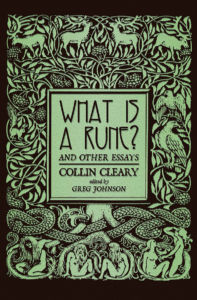
You can buy Collin Cleary’sWhat is a Rune? here
All geomythological sections that follow are sub-themes of this earliest and deepest topographical fissure — the sundering of the works of the gods’ creation from one another, so that afterwards there was discord, murder, and a marring of the natural world. Jewels became not only items of beauty and delight, but things to lust over, to spill blood over. Immortal Trees of Life withered, and became the symbols of mortality and the cycle of birth, error, violence, and death. Strangers were ever after the instruments of disenchantment. We have prayed for paradise, but remain fascinated with the underworld; we have embarked on adventurous journeys, all the while longing for our homelands; we have enjoyed the challenge of a riddle or puzzle, because finding the answers has satisfied our craving for a solution; we have dreamt of those places hidden from any outsider’s gaze, and we have cherished the thought of preserving their unspoilt kingdoms . . . yet we have coveted the sight of them and thus mounted many voyages of discovery to map them and drag them however unwillingly into the light.
II. Journeys and Destinations
The King beneath the mountains, The King of carven stone, The lord of silver fountains Shall come into his own . . . The streams shall run in gladness, The lakes shall shine and burn, All sorrow fail and sadness At the Mountain-king’s return![2]
The word “odyssey” means a long time of wandering and travels far afield; but it also rounds the circle in time and space, and means homecoming, at last. There in one word is encapsulated the next geomythological theme. As it had in its prequel, the Iliad, wrath and its chief promise, vengeance, began the poem, drove its plot, and harried the characters on their journeys by land and sea. As if the Achaeans had failed to learn any lessons while on the beaches of Ilium, they had once again angered Apollo, “the recklessness of their own ways [destroying] them all, the blind fools,” for they had “devoured the cattle of the Sun and the Sungod blotted out the day of their return.” Their captain Odysseus, lately King of Ithaca, would be “the man of twists and turns . . . driven time and again off course” by Hera, Poseidon, and countless other, lesser deities till after many trials and ten years, “he reached his native land.”[3]
Once sailing away from his triumph at Troy, Odysseus and his men were thrown amidst the tumults of the Aegean Sea, blown through the islands of the Cyclades and south to the beaches of North Africa, then wheeling in a criss-cross fashion from Sicily and Sardinia to the Italian coast, then round the boot and skirting Scylla and Charybdis. It was a map blending history and legend, truth and myth — dual themes that the most compelling stories have always comfortably merged. From these there followed a series of false paradises and enticing treasures — traps meant to keep Odysseus from his true bliss. Such snares included the pleasure-loving land of the Lotus Eaters; the heavenly voices of the Sirens bidding his sailors to take a fatal detour; a witch’s realm overflowing with wine, swine, and sweet-meats; and most alluringly, the goddess Calypso’s island. There, she kept Odysseus “captive” for long months, enchanting him with “her breathtaking voice as she glided back and forth before her loom, her golden shuttle weaving.” Around about her cave there grew “Thick, luxuriant” woods of “alders and black poplars, pungent cypress too, and there birds roosted . . . who make their living off the waves.” Twining down past the mouth of the cave there trailed “a vine laden with clusters, bursting with ripe grapes. Four springs in a row, bubbling clear and cold, running side-by-side, took channels left and right. Soft meadows spreading round were starred with violets, lush with beds of parsley.” Little wonder that a mortal man — even one as hardened and resolute as Odysseus — tarried there in such beautiful company. Why, even “a deathless god who came upon that place would gaze in [awe], heart entranced with pleasure.” Still, Odysseus had his “heart set on his wife and his return.”[4]
A great treasure waited for Odysseus at home. For perhaps the hundredth time, his son Telemachus climbed down and surveyed “his father’s storeroom.” It was
broad and vaulted, piled high with gold and bronze, chests packed with clothing, vats of redolent oil. And there, standing in close ranks against the wall, were jars of seasoned, mellow wine, holding the drink unmixed inside them, fit for a god, waiting [for] the day Odysseus, worn by hardships, might come home again. Doors, snugly fitted, doubly hung, were bolted shut.[5]
These unspoiled riches, symbolic of his similarly untouched wife and throne, were also symbolic of his family’s growing feelings of besiegement. For now they were protected, but treasures are only obsessively checked and then locked behind “snugly fitted” vaults, “doubly hung,” and “bolted shut,” when there is danger near of theft and rape. Indeed, there were serpents in Ithaca’s garden. Strangers vying for the throne and for Penelope’s hand had come with thoughts of defilement on their minds. The son watched as they camped within the absent King’s halls. Each day that the master of the house was absent was another day of hopeless stalling and taunts tossed in the faces of Telemachus and in those of his father’s loyal servants. “Look at them over there,” the young man sneered, “they feed on” another man’s goods and go scot-free — “a man whose white bones lie strewn in the rain somewhere, rotting away on land or rolling down the ocean’s salty swells.” But if that man were to appear and “come home in Ithaca, by god, they’d all pray to be faster on their feet than richer in bars of gold and heavy robes.”[6]
There and Back Again
Love of jewels and precious things can be pure, if it issues from the natural love of light: of Sun and stars, and how gold and diamonds can seem their like; of how emerald recalls the depths of a lover’s flashing eye, or aquamarine the surface glimmerings of wild falls and city fountains; how blue silk can seem like curtains fashioned from the sky. Yes, such a love of beauty is pure and healthy. When Tolkien’s dwarves (all of whose names appeared in the poetic Edda) sang their dirge:
Far over the Misty Mountains cold
To dungeons deep and caverns old,
We must away ere break of day
To seek the pale enchanted gold,
the hero-hobbit Bilbo Baggins “felt the love of beautiful things made by hands and by cunning and by magic.” But he knew, too, that it was “a fierce and a jealous love, the desire of the hearts of dwarves,” who equated treasure hordes with home.[7] Its title, There and Back Again, was a nearly perfect English translation of the double meaning locked in the word “odyssey.” And like Odysseus from the halls of Ithaca, the dwarves had been wandering exiles for many years, led by their King, Thorin Oakenshield. All had been cast out by a literal serpent — a fire-drake of that line spawned by Morgoth’s ancient evil. Smaug had taken over their fathers’ “storeroom, broad and vaulted and piled high with gold.” There he had lain, the worm, sleeping atop Erebor’s greatest gem: the Arkenstone, the King’s Jewel, The Heart of the Mountain, cut and fashioned by the dwarves, who had dug it out long ago. Like the Silmarils, it took “all light that fell upon it and changed it into ten thousand sparks of white radiance shot with glints of the rainbow.”[8]
Something came over Bilbo then, and the homebody-hobbit suddenly “wished to go and see the great mountains, and hear the pine trees and the waterfalls, and explore the caves, and wear a sword instead of a walking-stick.” For unlike the Odyssey, There and Back Again was a walker’s cross-country journey, directed by foot-path and forest, rather than a mariner’s travels, determined by wind and waves. Perhaps he made up his mind to go only when Gandalf the Wizard “in the light of a big lamp with a red shade . . . spread” on Bilbo’s dining table “a piece of parchment rather like a map.” Bilbo “loved maps, and in his hall there hung a large one of the Country Round with all his favourite walks marked on it in red ink.”[9] It was not the Arkenstone, nor any treasure lure, but a wrinkled old “plan of the Mountain” of Erebor and its archaic runes that attracted him. And even if Gandalf, the Grey Pilgrim, was not as glamorous as “grey-eyed Athena,” he was just as wise and persuasive a guide. This would be the great story of the age, Biblbo thought, just as Odysseus must have decided when the Greek warlords began spinning their tales of glory, golden apples, the rape of golden-haired wives, and then pointed to the coasts of Troy. How could he say “no?”
But if the plot was mostly driven by the dwarves’ desire for their own home and long-lost treasure, Bilbo’s motive — as the company faced monsters as fearsome as any mer-demon or scheming witch who turned men to hogs; and as they marveled at paradises that rivaled the most beautiful Mediterranean island-caverns — his motive became fixated on one thing: “getting back again.” Though he learned to sleep “curled up on the hard rock more soundly than ever he had done on his feather-bed in his own little hole at home . . . all night he dreamed of his own house and wandered in his sleep into all his different rooms looking for something . . .” He ached in his bones for “the homeward journey.”[10]
So, after “The dragon was dead, and the goblins overthrown, and [all] hearts looked forward after winter to a spring of joy,” Bilbo looked west beyond the blue distance and started for the Shire.[11] As he rounded the last turn in the trail before Hobbiton came into view, he sang of roads and maps, of how they
go ever ever on, Over rock and under tree, By caves where never sun has shone, By streams that never find the sea; Over snow by winter sown, And through the merry flowers of June, Over grass and over stone, And under mountains in the moon. Roads go ever ever on Under cloud and under star, Yet feet that wandering have gone, Turn at last to home afar.[12]
He’d ironically come back with the most valuable piece of jewelry in Middle-Earth, despite refusing a large share of the dwarves’ wealth. And I imagine that he set straight to work marking the paths of his “unexpected journey” in bold red ink and hanging the new, larger map of the north country above his others in those cozy halls under the hill . . .
Though not before he had to chase off a crowd of intruders auctioning off his goods; not before the “legal bother” that lasted for years “before Mr. Baggins was in fact admitted to be alive again”[13] — the humorous, English provincial version of Odysseus’ wrathful clearing of the riff-raff infesting his own house upon his arrival at Ithaca.
III. Puzzles and Answers
The lives of the Greeks in the old days [are] deep, mysterious, and often lead to questions like just what was wrong with Ariadne anyway . . ?[14]

You can buy Tito Perdue’s Materials for All Future Historians here.
Anyone who has read my essays before knows (and probably shares) my love of mystery and symbolism. And what single sheaf of paper has more of these than a map? Each city, long-ago battle, old forest, and “Little Pine Lake” has its symbol marked, then explained in a key. But for all a map’s sometime precision, or explained landmarks, it retains its aura of a sphinx challenging viewers’ wits. The map, you see, is often the real mystery — a journey of the mind. Thorin Oakenshield’s map of the Lonely Mountain, for example, revealed a “secret entrance” to its caves — alluded to with a “hand pointing to it” from the runes. How had it remained a secret for so long? “In lots of ways,” Gandalf answered, “and I should guess there is a closed door which has been made to look exactly like the side of the Mountain.”[15]
Then, the wizard produced from his robes with a flourish “a small and curious key” — the literal manifestation of a key that has appeared on almost all maps and that have decoded their signs. Unable to decipher the messages hidden within, the company enlisted the help of old Elrond of Imladris (Rivendell). The elf-lord “took it and gazed long at it,” while “The moon was shining in a broad silver crescent.” The elven hall was tiled all in white, and it glowed in the moonlight. Bilbo felt like he was watching from inside the Moon itself. Holding up the map, Elrond saw this “white light [as it] shone through the markings. ‘What is this?’ . . . ‘There are moon-letters here, beside the plain runes which say ‘five feet high the door and three may walk abreast.’” They were moon-runes, invisible even when one looked straight at the text, for they could “only be seen when it [shone] behind them, and . . . it [had to] be a moon of the same shape and season as the day when they were written.” The illuminated words instructed the dwarves to “Stand by the grey stone when the thrush knocks” and behold: “the setting sun with the last light of Durin’s Day will shine upon the key-hole.”[16] Thus The Hobbit, readers, with its burglars and map-riddles, was a detective story.
Christie’s Toward Zero
Many people do not associate Agatha Christie’s mystery stories with maps, but so often floor-plans and the geography of space were central to unraveling the schemes of murderers and theives — dictating their movements and the time necessary to commit their crimes. Towards Zero began with a map of Easterhead Bay. From Lady Tressilian’s house atop a steep cliff and overlooking the River Tern, she could see from her back window to “the other side of the river.” The newly-created summer resort of Easterhead Bay “consist[ed] of a big sandy bathing beach, [while] a cluster of modern bungalows and a large Hotel on the headland looked out to sea.” Saltcreek itself was a straggling picturesque fishing village set on the side of a hill. Like the Lady herself, the town was “old-fashioned, conservative and deeply contemptuous of Easterhead Bay and its summer visitors.” To Lady Tressilian’s consternation, the Easterhead Bay Hotel was nearly exactly opposite her house,” an eyesore that now stood “in its blatant newness.” Thank goodness, she thought, that her late husband Matthew “never saw that vulgar building. The coastline was quite un-spoilt in his time.”[17] As far as she was concerned, she lived in a paradise, lost.
So, when Lady Tressilian’s guests — her nephew and tennis champion Neville Strange, his wife Kay, his ex-wife Audrey, Kay’s hanger-on, Ted, retired lawyer Mr. Treves, and the prodigal family friend Thomas Royde, home from the colonies — discovered that someone had murdered her in bed, the police inspector began poring over the local map. A brutal assault had perverted the place and turned the peninsula into a murderous pit. Oh, “I like a good detective story,” Treves admitted, “But, you know, [those storytellers] begin in the wrong place! They begin with the murder,” hardly realizing that “the murder is the end. The story begins long before that” — years before sometimes — with all the causes and events that bring certain people to a certain place at a certain time on a certain day, and “All converging towards a given spot.” When at last, “the time comes . . . Zero Hour. Yes, all of them converging towards zero,”[18] towards the “last light of Durin’s Day.”
Using the map, the detective deduced that only the fit Neville Strange could have swum the cold river at night, hiked the shore cliffs, climbed a rope that he had left hanging from his old bedroom window, then killed his aunt in a moment of vengeance — an act to punish the old woman for threatening to change her will and leave her jewelry and mansion to another, certainly. But Strange’s true aim was the framing of his ex-wife, so that she would swing from the hangman’s noose. It seemed that affably evil Strange was the principal intruder (and not the garish Hotel) who had marred the perfection of his childhood home.
Labyrinth at Knossos
Strange’s crime was like a tryst in a meadow compared to the human sacrifice going on in the Minoan island of Crete, an ancient wonder described in the Odyssey as “ringed by the wine-dark sea with rolling whitecaps — handsome country, fertile, thronged with people well past counting . . .”[19] But to quote another of Agatha Christie’s novels about revenge, treasure hunts, and puzzle maps of pseudo-island paradises, “everywhere there is evil under the sun.” A sober author, with an insistence on historicity and fact, Plutarch compared himself to “geographers . . . who crowd[ed] on to the outer edges of their maps” explanatory notes that warned: “What lies beyond is sandy desert without water and full of wild beasts,” or “blind marsh,” or “Scythian cold,” or “frozen sea.”[20] The earlier periods of which he sometimes wrote might as well have used similar language: “What lies beyond is full of marvels and unreality, a land of poets and fabulists, of doubt and obscurity.” His Bronze-Age account of Theseus and the Minotaur was therefore a tale of mythic and uncertain provenance.
Long ago, the small kingdom of Athens had angered the gods, and for this its residents suffered dried-up rivers and “barrenness and pestilence” for many seasons. Soothsayers claimed that the “wrath of heaven would abate and there would be an end to their miseries” if they reconciled themselves with King Minos of Knossos, Crete. After sending a delegation to Minos, “they made supplication and entered into an agreement to send him every nine years a tribute of seven youths and as many maidens.” According to traditional accounts, the vengeful king threw them into an impossible puzzle-maze inhabited by a monster “of mingled form and hybrid birth,” known as the Minotaur. “Unable to find an exit,” the tributes died there, and the Minotaur devoured their bodies.[21]
Dædalus, the famous architect father of Icarus, had designed this labyrinth that “confound[ed] the marks of distinction, and [led] the eyes into mazy wanderings, by the intricacy of its various passages.” Its paths “flow[ed] backwards and forwards with its varying course,” and so numerous were its “windings,” that even its maker possessed of its map and blueprints of its halls could scarcely have “return[ed] to the entrance.”[22] Amidst the wealth and pomp of an ancient paradise, there lurked a pit wherein a foul beast, half man and half bull, indulged his taste for young and tender flesh. Now, the Athenian ruler sent his own son Theseus as a tribute. His instructions were to solve the maze-puzzle, kill the Minotaur, and then return home on a ship with white sails — the sign they agreed upon to communicate Theseus’ success.
Luckily for the young hero, Minos’ daughter, the princess Ariadne, fell in love with Theseus and gave him a “clew”: a ball of yarn with which to mark his way in the labyrinth and which would lead him back to the entrance after he had slain the horned Minotaur. In return for her help, Theseus promised to marry her. As Ariadne had bid, so Theseus unspooled the yarn behind him, until he came upon the monster. A fierce struggle ensued that bloodied both opponents, but Theseus finally managed to strike down the Minotaur with a mighty blow from his sword. And when he emerged victorious, Theseus crept back with his countrymen to his ship and to the sleeping form of Ariadne, waiting for him. But he did not keep his word to marry Minos’ beautiful daughter, and left her behind for home, full of pride and victory (and besides) 13 ex-virgins onboard. Ariadne was one of those people “who [was] never in doubt,” he thought. And when Theseus further contemplated “their future together, how she would correctly foretell the mystery or banality behind each locked door,” he shook his head right then and decided to abandon her. Who wants to live in a world without puzzles?[23] Whatever the flawed hero’s logic, human treachery seldom went unpunished in Greek mythology. Perhaps as retribution for his breach of honor, the gods caused Theseus to forget about the white sails amidst his celebration of wine and riches, and he came ever closer towards his fathers’ port, sails still arrayed in their black colors. When his father saw this, he flung himself onto the Aegean’s rocks and to his death.
It may not seem to have had much resemblance to Tolkien’s or Christie’s modern novels, but the myth of the Minotaur in the labyrinth was also about the keys to puzzles, fictional geographies, faithlessness, homecoming, and death that lurked at the roots of mortal homes; of dark hearts and the darker deeds of strangers lustfully consuming the beautiful, the virginal. Meanwhile and quite apart from Dædalus’ maze was the equally vexing question of Theseus’ ship. The vessel on which he and the other youths of Athens had returned “had thirty oars, and was preserved by the Athenians.” Each time an old plank had decayed beyond keeping, “they took [it] away . . . putting in new and stronger timber in [its] place, insomuch that this ship became a standing example among the philosophers, for the logical question of things that” change, or “grow.” On one side were those who claimed “that the ship remained the same, and the other [contended] that it was not the same” in any of the essentials that mattered[24] — namely, the physical ones. What to do? — let the old and venerable rot away until at last it returned to dust and clay; or mend it regularly with fresh supplies of wood and cloth and infusions of new blood, until the thing one had preserved had really been replaced with a model, an artifice of the original? Those ancient Greeks and their philosophical mazes about the Profound Questions; those inventors and mapmakers of the mind in whose footsteps still we drop our little strings!
IV. Hidden Cities and Discovery
Come forth, O valiant Castilian Lord! Old victories you’ve hung upon your sword, But boundless and better there is than before If ride thus we go to seek our reward At Quivira . . .[25]

You can buy Collin Cleary’s Wagner’s Ring & the Germanic Tradition here.
In mythology, those who live sequestered and safe in hidden cities and those who search for them, both seem to always meet a catastrophic end by way of hubris and greed. This section’s focus is the geomythology of fabled kingdoms seldom reachable by any map, even if they appeared on them. Long before Bilbo’s trek to the Lonely Mountain and in the First Age of Middle-Earth, the Noldorin elves who had followed Fëanor went about establishing their own kingdoms in the north. There they besieged the Dark Lord Morgoth in a stalemate that lasted for 400 years. Then came the Dagor Bragollach: the Battle of Sudden Flame. Morgoth “sent forth “great rivers” of fire that poured over all the plain. The “Mountains of Iron belched forth many . . . poisonous hues, and the fume of them stank upon the air and was deadly.”[26] The Enemy had broken the siege. In the days and months and years that followed, the greater part of the Noldor perished in battle, including their valiant King, Fingolfin.
After these defeats, Fingolfin’s son Turgon decided to build a hidden city within the Encircling Mountains of Echoriath (a large caldera of a once-active volcano). Turgon named this new settlement Gondolin (Hidden Rock). Its protections included the great eagles of the West patrolling the skies above it; Ulmo, the god of all waters; and strong borders barred by invisible doors and seven gates. Inside this sanctuary and “upon the fair vale of Tumladen, set as a green jewel amid the encircling hills” lay Gondolin the Great, “city of seven names, whose fame and glory [was] mightiest in song of all dwellings of the Elves in the Hither Lands.” Trumpets blew on the towers of the gates and from “the white walls of the city, flushed with the rose of dawn upon the plain.”[27] But Ulmo warned Turgon from the beginning not to become too attached to his new paradisiacal kingdom — to hesitate not to leave it behind when or if a messenger might someday arrive with disturbing tidings. Though he heard, the King did not listen.
As usual, an intruder did manage to find his way in. Maeglin, the nephew of Turgon, found the “Hidden Rock” when he and his mother journeyed back to her home of Gondolin in order to save them both from his father’s stifling control. There, Turgon welcomed Maeglin as a kinsman and raised him to a high position in the royal household. But whether from some darkness inherited from his bitter and wrathful father, Maeglin succumbed to a perverse love for Idril, Turgon’s daughter and Maeglin’s first cousin — a forbidden attachment. For her part, Idril disliked and distrusted the newcomer and found his attentions loathsome. Thus it was “in Gondolin; and amid all the bliss of that realm, while its glory lasted, a seed of evil was sown.”[28]
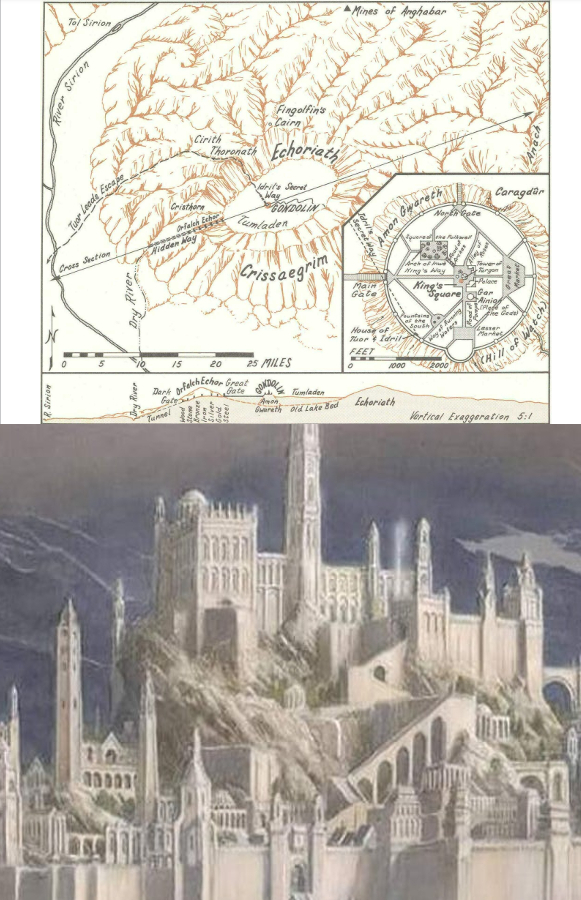
A close map study of Gondolin from Karen Fonstad’s Atlas of Middle-Earth, and Alan Lee’s illustration below.
While out quarrying for rock unwisely beyond Gondolin’s girdle of protection, Maeglin was captured by a band of goblins, then taken to Morgoth’s Iron Hells to be questioned. Morgoth had long known of Gondolin’s existence, but because he knew not its location, he could make no violence against one of the last great elvish realms of the West. Once again, he burned with envy and malice. With Maeglin now in his custody, he seized his chance. Promising the young elf prizes of wealth, power, and Idril’s hand in marriage, Morgoth manipulated Maeglin into revealing Gondolin’s whereabouts — the worst act of treachery in the entire Tolkien legendarium. It is safe to assume that he now stares fixedly out from the Seventh Circle’s frozen lake. Gondolin and its people had at last run out of time. Despite several warnings, Turgon refused to leave his beloved refuge where he was a splendid King and where his people had blissfully dwelled in isolation for centuries.
Thus, when Morgoth deemed himself ready for an assault upon the hidden kingdom, his hosts “came over the northern hills where the height was greatest and the watch least vigilant, and it came at night upon a time of festival.” As all the people of Gondolin watched from their walls “to await the rising sun and [to] sing their songs of its uplifting,” they saw instead a red light mounting the hills in the north and not the east.[29] Dragons and balrogs and goblins streamed onto the plain beneath the city, and Gondolin’s warriors — brave and mighty though they were — fell to their foes. Its proud towers collapsed, and Turgon fell alongside the majority of his trapped subjects. So was the greatest jeweled city of the West, the glittering white castles of this elvish home, overthrown in one horrific day. Its ruins are now only a memory on long-forgotten maps. Gondolin, like all paradises, was fragile and enjoyed but a fleeting moment in the Sun, then fell into that cosmic pit that hordes all the other fragments of humanity’s lost monuments once raised to an immortal beauty that it seems the Earth cannot bear for long.
Lost Cities of Gold and Cinnamon
If we have any true, modern fairy tales to rival those of Gondolin, Erebor, and the Odyssey, they must be those adventures of the Spanish and Portuguese conquistadors, who claimed, traveled, and mapped the New World. These were mythological characters embarking on equally fantastical quests. Trinidadian author V. S. Naipaul was correct when he said that “For the conquistador the El Dorado adventure ended in kidnap, solitude, and lunacy. His province — the dream of the third Spanish marquisate in the New World, after Mexico and Peru — became the ghost province of the Spanish Empire.”[30] In the sixteenth and seventeenth centuries, these Iberian adventurers became convinced that a city of gold, alongside groves of trees whose bark flaked precious cinnamon and pepper spices, lay hidden somewhere in the vastness of the South American jungles.
One such man — a creole (a pure-blood European born in the colonies) by the name of Alonso de Ovalle — made an engraved map of his Chilean home for the perusal of the Spanish monarchs. In it, he conveyed “a paradisiacal vision of southern South America compiled from memory and from resources which Ovalle deemed to be of merit, incorporating European map signs and iconographies.” He drew attention to “the abundance of nature represented on the map — gold mines, plants and animals.” Certain details of Ovalle’s homeland “stood out as pure fantasy,” such as his inclusions of “cinnamon and pepper plants growing in Patagonia along the Strait of Magellan.”[31] Chile could boast of no great mineral deposits of emerald or silver to rival the other colonies of the Americas, and Ovalle wanted to convince the Spanish King that Chile was a worthwhile investment — that it might even have had in excess the exotic Asian resources so lucrative in the early-modern market-place.
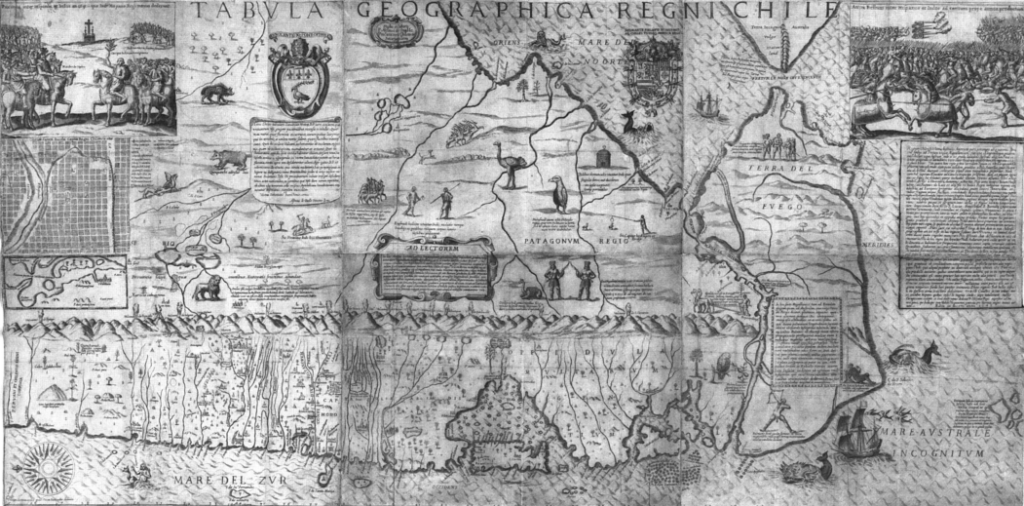
Ovalle’s 1646 map from Burdick’s article; note the early use of “Tierra del Fuego,” Land of Fire for the extreme south of the continent, as well as the various representations of exotic animals.
Others were even bolder in their dreams. They began to hear stories “swirling about, frenzied rumors that titillated . . . already gold-lusty imagination[s].” Most tantalizing of all were repeated tales “about a literal ‘golden man,’ the Gilded One or El Dorado, an Indian King so fabulously wealthy that daily he charged his subjects with coating his naked body from head to toe with new gold dust.” At the end of each day he bathed in a lake, lining its bottom with gold. Other chiefs — his ancestors, so the story went — “had performed the ritual dusting and bathing for untold generations.”[32] But where in the primeval rainforests were this King and this lake? Many expeditions were launched, all failures and most deadly ones, at that. Gonzalo Pizzaro’s own quest in the 1540s made for the province of Quijos, the most likely region, he reckoned, where El Dorado’s kingdom of gold waited in the mists. Though his entourage “had begun at the equator, soon they had climbed high enough to see their breath in plumes, and beyond, the forbidding domes of snow-covered, active volcanoes.”[33] It was indeed a paradise, but not a golden one. Nor was there any sanctuary from the flies, blood-drinking bugs and bats, sharp branches that caught on flesh, the merciless humidity, nor the poisoned fangs of Indian arrows.
The fool’s errand of El Dorado was an inversion of old Gondolin. Plenty of natives flocked to the Spanish, eager to feed them a steady diet of tall tales that featured Cíbola and Quivira. But not one hidden city of riches ever emerged from the tangled, dripping, and vegetation-choked jungles of the Amazon. Whatever spells of protection encircled this gilded kingdom, that lost city of strange jaguar gods and idols of spice and heady fountains of youth, it caused all seekers to find nothing but grief and mortality. Europeans sacrificed hundreds of their own number in the search, their bones lying sickled and hidden and finally devoured by Nature in her most overwhelming and lustful form. The cavern-womb of Calypso pales. Before Ovalle, meanwhile, could finish the task of rounding the southern horn with his map of dreams beneath his arm and bound for the Spanish court, his home in Chile suffered a devastating spate of earthquakes and volcanic eruptions. He reversed his course, then soon after died a broken man. The Chilean rapture of his was no more, and his cities of cinnamon never were. O! — once again, the Long Defeat.
These maps of fantastic places, of fictional men, of Christian Scripture, of pagan gods, and heroes long ago — they repeat a truth in different words and in different realms, but in gestures familiar and in like landscapes, every one. We are a race both blessed and cursed with always wanting more. By those desires do we often create magnificence while sometimes losing the one small, obvious, but most essential thing of all. Gaze in awe at beautiful maps, but never let the eye stray too far from the borders of blood and soil, lest in your wandering inattention your spring paradise of Dogwood or silvery starlight becomes a pit.
I don’t usually dedicate pieces, but after having written and read so much about the subject now, I am compelled to commit this one to all the long-time gone Western adventurers and cartographers. Whether in myth or in fact, the world you mapped has never again seen your like.
* * *
Counter-Currents has extended special privileges to those who donate $120 or more per year.
- First, donor comments will appear immediately instead of waiting in a moderation queue. (People who abuse this privilege will lose it.)
- Second, donors will have immediate access to all Counter-Currents posts. Non-donors will find that one post a day, five posts a week will be behind a “paywall” and will be available to the general public after 30 days.
To get full access to all content behind the paywall, sign up here:
Paywall Gift Subscriptions
 If you are already behind the paywall and want to share the benefits, Counter-Currents also offers paywall gift subscriptions. We need just five things from you:
If you are already behind the paywall and want to share the benefits, Counter-Currents also offers paywall gift subscriptions. We need just five things from you:
- your payment
- the recipient’s name
- the recipient’s email address
- your name
- your email address
To register, just fill out this form and we will walk you through the payment and registration process. There are a number of different payment options.
Notes
[1] Dante Alighieri, The Divine Comedy, John Ciardi, trans. (New York: New American Library, 1970), 47-8.
[2] J. R. R. Tolkien, The Hobbit, or There and Back Again (Boston: Houghton-Mifflin, 2013), 244.
[3] Homer, The Odyssey, Robert Fagles, trans. (New York: Barnes & Noble Classics, 1997), 1-3.
[4] Ibid., 79.
[5] Ibid., 29.
[6] Ibid., 238.
[7] The Hobbit, 16-18.
[8] Ibid., 245.
[9] Ibid., 23-4.
[10] Ibid., 178.
[11] Ibid., 250.
[12] Ibid., 369.
[13] Ibid., 370.
[14] Stephen Dobyns, “Theseus within the Labyrinth” in Poetry Magazine, February 1986, 282.
[15] The Hobbit, 24.
[16] Ibid., 65-6.
[17] Agatha Christie, Towards Zero (New York: Haper-Collins, 2005), 30-1.
[18] Ibid., 9.
[19] The Odyssey, 321.
[20] Plutarch, “Life of Theseus” in Lives, vol. 1, Bernadotte Perrin, trans. (Cambridge, UK: Loeb Classical Library, 1914), xi.
[21] Ibid., Chapter 15.
[22] Ibid.
[23] “Theseus within the Labyrinth,” 283.
[24] “Life of Theseus,” 50.
[25] My own verse, with the excuse that I have read too much Tolkien lately not to try something like this.
[26] The Silmarillion, 146.
[27] Ibid., 245.
[28] Ibid., 134.
[29] Ibid., 250.
[30] V. S. Naipaul, The Loss of El Dorado: A Colonial History (New York: Vintage, 1997), 7.
[31] Catherine E. Burdick, “Patagonian Cinnamon and Pepper: Blending Geography in Alonso de Ovalle’s “Tabula Geographica Regni Chile” in Imago Mundi 66, no. 2 (2014), pp. 196-214, 196.
[32] Buddy Levy, River of Darkness: Francisco Orellana’s Legendary Voyage of Death and Discovery Down the Amazon (New York: Bantam, 2011), 30.
[33] Ibid., 38.
Mortal%20Instruments%3A%20Mapping%20the%20Geomythologies%20of%20Western%20Fantasy%2C%20Part%20II
Enjoyed this article?
Be the first to leave a tip in the jar!
Related
-
James M. McPherson’s Battle Cry of Freedom, Part 2
-
Right-Wing Values in the Halo Series
-
Looking for Anne & Finding Meyer, Part 3
-
Looking for Anne and Finding Meyer, Part 2
-
Looking for Anne and Finding Meyer, Part 1
-
National Socialism as a Magical Movement: Stephen E. Flowers’ The Occult in National Socialism
-
Counter-Currents Radio Podcast No. 580: On Dealing with the Decline of the White World with Millennial Woes and Morgoth
-
Counter-Currents Radio Podcast No. 579: New Ask Me Anything with Millennial Woes

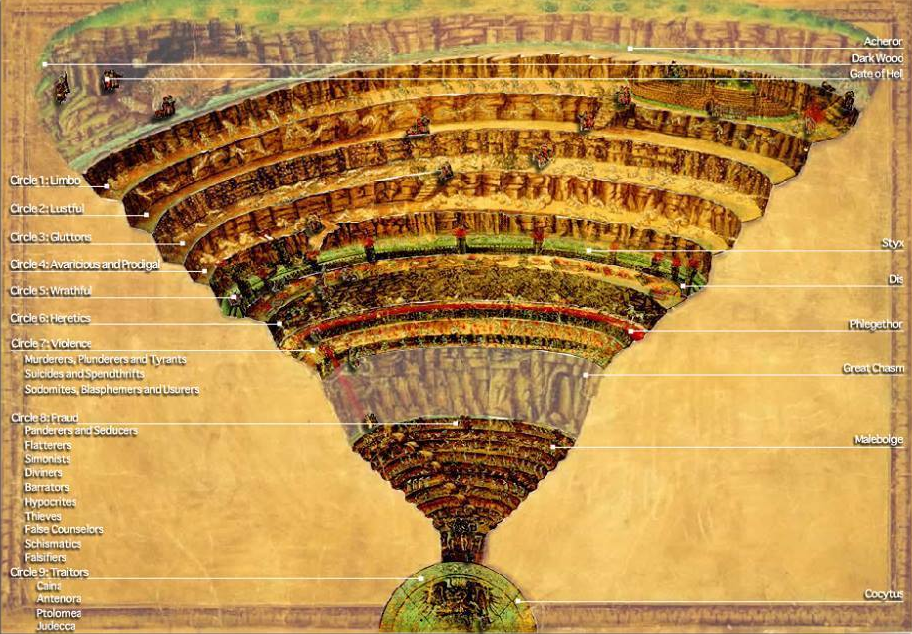
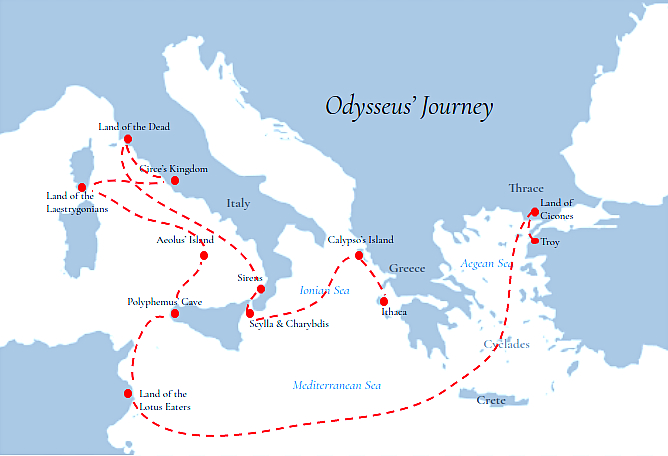
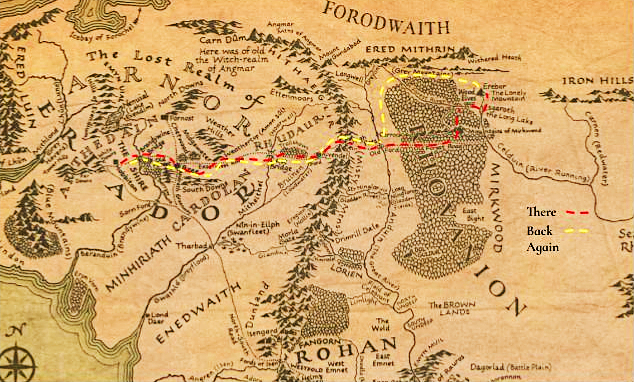
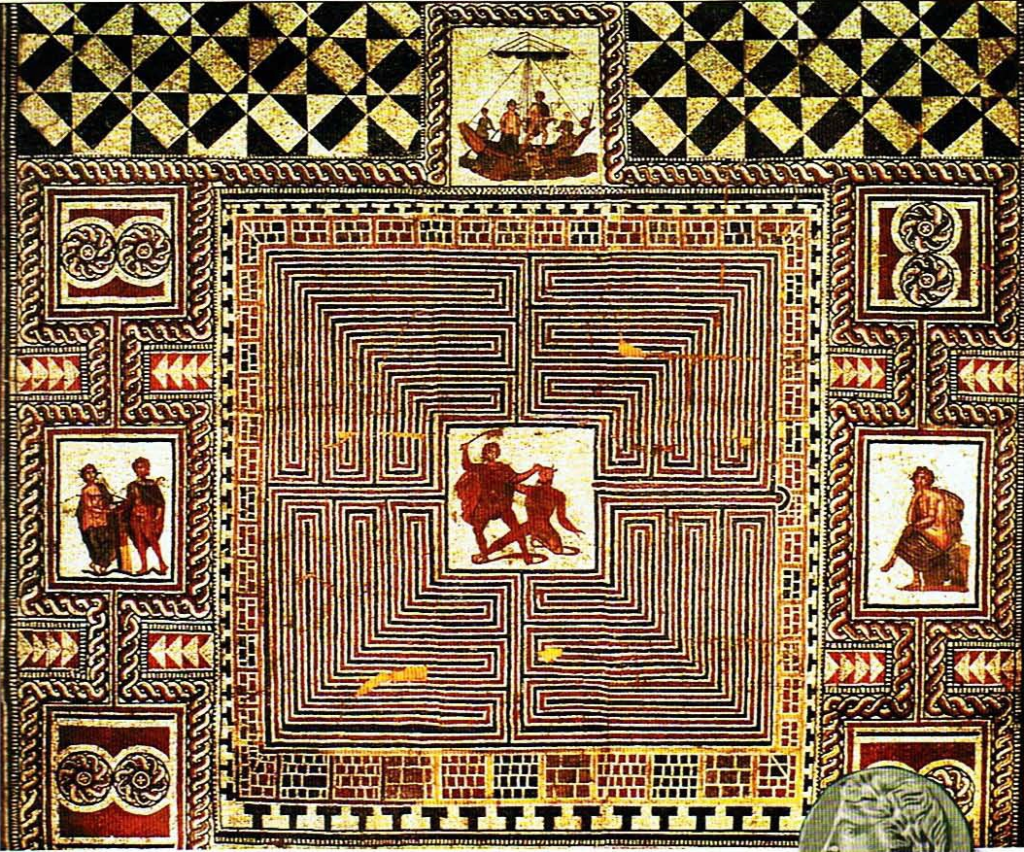
6 comments
I remember being enthralled as a kid by the map of Middle Earth at the start of The Hobbit. A love of exotic fantasy lands is what drove me to become a big reader, and it only continued. I loved looking at maps of antiquity with places and tribes with names like Cappadocia, Silures, Thessaly and Uruk.
This is why I love C-C — so many of us are on the same wavelength when it comes to the important, tasteful, and beautiful things. I have no empirical evidence for this hypothesis, but I suspect that most map-lovers are men and women of the Right. Something in the blood stirs, old and fortifying, when taking in a map like that of Tolkien’s Middle-Earth.
Thank you, Mr. Steuben!
There is a joke floating around on the internet that the favorite video games of right wing young men, Hearts of Iron, Civilization, Crusader Kings, Europa Universalis, etc. are simply “staring at a map for hours on end.” I agree. Maps are enchanting, interactive maps even more so.
Ever since I was a child, I was fascinated by maps and atlases, because they were portals to the wider world. I find that a love of maps is the makings of a world-consciousness, an interest in the broader world, something which most people lack, but a select few possess. It is the mark of a higher type of man than someone content, like Tolkien’s hobbits, to remain in his own little corner of the world.
Ha — now that you mention it, I do remember some of the complaints lobbed at online empire games, one of them being that they catered to the Bad Sorts.
That’s a good point about maps and encouraging a healthy interest in other places. An embrace of ethno-nationalism doesn’t mean that we should take no notice of the world beyond. I think a love of maps can encourage a curious combination of provincialism (not necessarily in a bad way) and, as you say, “world consciousness.” Notice, that whenever someone looks at a world map, his eyes will usually be drawn first to find what he considers to be “home,” then his gaze goes from there. The English, for example, the models for Tolkien’s hobbits, often exhibited this blending of consciousnesses. I think it’s healthy for young whites, particularly young white men, to have a sense of adventure. I can’t, however, advocate a new crusade to seek out El Dorado. Although . . .
These really are a joy to read, Kathryn.
Many rabbit holes to go down while reading these (cave paintings, Minoan Thera, etc.)
Excellent.
Thank you, Gaddeus! I look forward to our next meeting, when our paths cross again in this region’s realm of misty lakes, cloudy winters, golden Septembers (and unfortunately quite a few orcs to watch out for).
Comments are closed.
If you have Paywall access,
simply login first to see your comment auto-approved.
Note on comments privacy & moderation
Your email is never published nor shared.
Comments are moderated. If you don't see your comment, please be patient. If approved, it will appear here soon. Do not post your comment a second time.
Paywall Access
Lost your password?Edit your comment